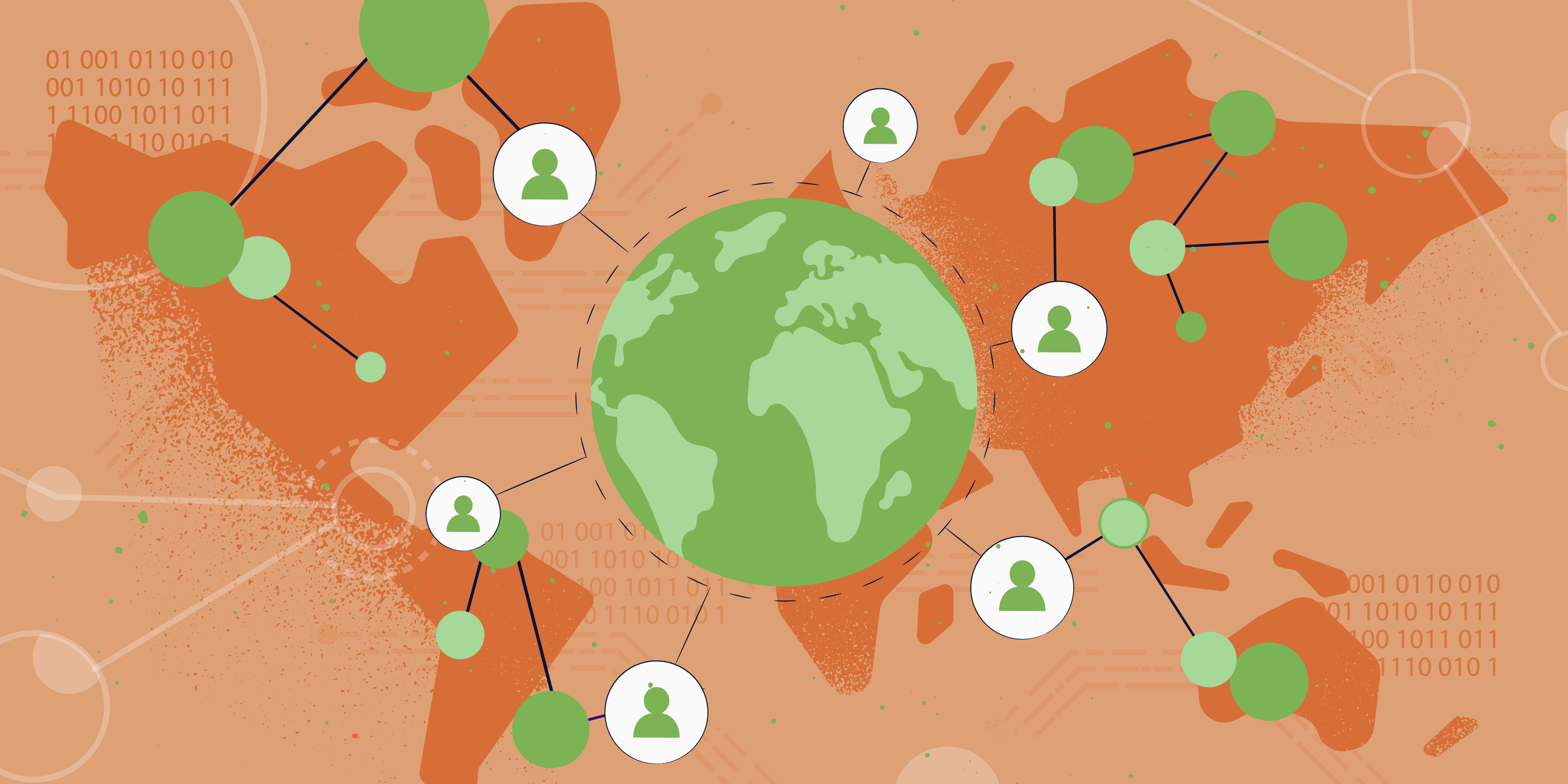
Listen to Geo-Agnostic Team Building How To Build Your Own (8 mins):
As vaccines enable organizations to return to “normal” not everyone is ready to forget the lessons we’ve learned about remote work during the pandemic. Several companies have embraced the geo-agnostic team model because of the pandemic and have little interest in shifting away from it. However, Feedzai has always been this way. Here’s why.
More than a year ago, the coronavirus pandemic lockdowns left companies across the globe scrambling to adjust their workplace (seemingly overnight) to a fully remote model. As the months dragged on, face-to-face meetings declined, Zoom sessions became the norm, and the end of remote working was nowhere in sight.
But as people adjusted to new routines and started working from home offices, we realized our worries of unproductive and disengaged employees were merely unfounded anxieties that never came to fruition. Instead, we saw that being a completely remote workforce does work. With a new sense of confidence, more places embraced remote-first, remote-only, or hybrid models for the post-pandemic world, creating a hopeful future: a geo-agnostic team model without boundaries.
Applicant tracking systems and job boards adjusted their offerings to now support remote job postings and distributed workforces. As new talented people entered our pipelines from locations we’ve never reached before, it was easy to want to jump into the geo-agnostic workforce environment with both feet.
But before you go on a remote workforce hiring frenzy, it’s important to consider the realities of this freedom. After living in five countries and working as an HR leader at geographically diverse companies for more than 20 years, these are the five key things you should consider before creating a geo-agnostic team.
First, let’s talk about the benefits of a geo-agnostic team
There are plenty of good reasons to build a global team. However, here are the three most notable:
- You can go where the talent is, widening your candidate pool with more skilled people who can work from anywhere.
- You’ll improve your team’s diversity, increasing learning, innovation, and growth opportunities, and impacting your bottom line.
- You can operate where your customers are so you can meet their needs and service them better.
So, what are the geo-agnostic team model trade-offs?
There are plenty of challenges that come with the benefits of building a geo-agnostic team. Although this isn’t an exhaustive list, these are some of the most important questions to consider.
Do you want to be everywhere or only in specific locations?
Maybe the most obvious challenge is the language barrier. If you’re recruiting within a specific country, will this person be able to communicate effectively with the teams they’ll work with? Will they understand the primary language used across the company?
Another consideration relates to the legislative environment. Some countries’ legislation favors businesses where others favor the employees. Are you aware of the challenges you may face in the locations you’re considering?
Or maybe countries have sanctions that can make the process a headache. For example, if there are specific rules about data and privacy, this may require different infrastructure or policies to meet those laws.
You may also need to determine how you’re going to do business there. Are you going direct, the partnership route, or bringing in an employer of record?
Will cultural differences impact trust?
Every culture has their own nuances. Those who aren’t from one culture may never realize the subtleties of another culture. This isn’t as simple as misunderstanding a colloquialism. It could be that one employee makes a small gaff and was completely oblivious to the fact that it was offensive to another employee. How can you educate your employees to avoid these issues?
How about ensuring the candidate and employee experience supports all people, not just the majority? Different cultures have varying values and expectations. Therefore, you need to train your recruiters, interview panelists, and hiring managers to understand the unique ways people answer interview questions and uncover the hidden meanings in what’s being said and not said. Is your recruiting and onboarding process unwittingly excluding people?
These are just a couple examples of how something seemingly harmless could impact whether an employee trusts the company or the people they work with regularly. Without this trust and respect, your company culture can be seriously damaged.
A good assessment tool to use is the Erin Myers Culture Map. This can help you as you consider working with different countries and cultures.
How will you keep your employees informed and engaged?
You need to have a deliberate communication strategy. It’s not just about ensuring everyone gets the message, but that they’re getting the right message.
First, there are the challenges of time zones and how synchronous vs. asynchronous communication creates different experiences. Realistically, you won’t get everyone on the same call for something like a company-wide meeting. If you don’t have everyone receiving important messages at the same time, how will you write the follow-up communications so they land? How will you ensure people are seeing it in a timely manner, especially if it’s time-sensitive? And how can you equip leaders to reinforce those messages so they don’t get lost?
The challenges of having groups of people miss these live communications means they’re not able to ask questions, which changes their experience. Or, if you’re keen on setting up multiple live sessions so these employees don’t feel isolated, how are you providing support for those leading the discussions?
For instance, if someone based in the United States needs to drive key messages for the US, EMEA, and APAC, that makes for a long day for the speaker. On the other hand, if there is only one call available, this makes for a long day for the employees who want to be present.
Then there are the small overlap opportunities to consider. You may find people are overwhelmed with meetings clustered in short windows, causing meeting fatigue. Or, they’re fighting to get time on someone’s calendar, which can delay outcomes. How can you create a culture that’s productive and while also empowering work-life balance?
How are you onboarding new employees?
Logistics can get tricky when shipping to different countries, and it’s important to factor this in. For example, if you have a new hire starting in two weeks, but packages take nearly four weeks to get through customs, how will you get their equipment to them in time?
How will you help your employees connect with the right people to create a good onboarding experience? If someone is going into an office and another person is doing it completely telephonically, this leads to different onboarding experiences and may require adjusting your strategy to create a more consistent experience.
How will you reinforce your culture?
I believe many of us can see how a situation like going fully remote during the pandemic can test your company culture. When you can no longer rely on things like in-person relationship-building or in-office benefits, will your culture still offer enough to create a solid employee experience? Will employees feel disconnected or forgotten?
This is where deliberate communication is essential. It’s not just about creating programs to keep the fun alive, it’s also about building trust through consistent and transparent messages, creating processes to keep people engaged, ensuring people understand what it means to join your company, and helping people stay on track.
You need to make a conscious effort to work on this constantly. If you take your eye off the ball for even a second, it can all come tumbling down.
Be thoughtful in building your team
The benefits can be exciting, but it’s wise to do your research before you get in too deep. Company culture and the employee experience have to be at the forefront of your decisions, because those outcomes touch every part of your business, including your bottom line.
Understand the tradeoffs, and plan and manage for that. This includes increased awareness and training, as well as reinforcing communication and opportunities. I’ve seen the amazing things that can happen when a multicultural team is done right. I hope these insights can set you up for success.
Let’s fight financial crime and fraud together. Feedzai is hiring worldwide. See our open roles here.
Share this article:
Related Posts
0 Comments11 Minutes
#MyAI: Customer Choice and Consent in the Generative AI Age
From chatbots to call centers to loan applications and beyond, artificial intelligence…
0 Comments11 Minutes
Feedzai Fraud Frontlines: Cloud Migration Done Right
We’re on a mission to help banks and financial institutions shield their customers from…
0 Comments6 Minutes
How Feedzai Supports Mental Health / Menstruation at Work
At Feedzai, we have a reputation for being risk-takers and innovators. In our product, in…



